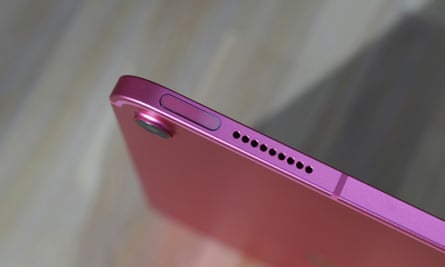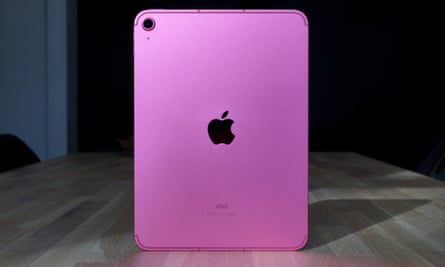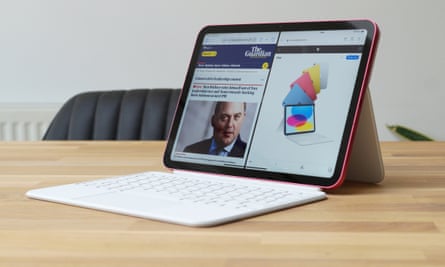Apple’s base model iPad gets a much-needed modern redesign with a bigger screen and a bunch of new accessories – but also a nasty price increase.
The 10th-generation iPad costs from £499 ($449/A$749). Apple is still selling the old ninth-generation iPad for £369, while the similarly sized iPad Air costs £669 after price increases due to weak currency rates.
The price is certainly less tempting than previous models, but this is the first time in roughly seven years that Apple has updated the design of its low-end tablet. It looks like a clone of the current iPad Air, and inherits the sleeker, flatter body used by other iPad models since 2018.

The home button and large bezels are gone, allowing a larger 10.9in screen to fit in a body that is about the same size as its predecessor. Small and light enough to easily slip into a bag, it is a great improvement.
It has stereo speakers when held in landscape, which are ideal for watching movies. There’s a modern USB-C port for charging and connecting peripherals. The automatic pan-and-scan webcam has been moved to the top edge when held in landscape for the first time on an iPad, which is much better-placed for video calls. The 3.5mm headphones jack is gone, meaning you will need a USB-C adapter if you want to use wired headphones, so it is not all good news.
Compared with the iPad Air, the screen isn’t quite as good, with slightly worse colour representation and no anti-reflective coating, which makes it more difficult to see in direct sunlight.

Oddly, the new iPad doesn’t share all the same accessories as either its predecessor or the iPad Air and Pros. It supports the first-generation Apple Pencil stylus, not the second-generation used by other iPads. It has a new smart connector on one edge, which connects to a new Magic Keyboard Folio, not any of Apple’s other keyboards.
Specifications
-
Screen: 10.9in 2360×1640 Liquid Retina display (264ppi)
-
Processor: Apple A14
-
RAM: 4GB
-
Storage: 64 or 256GB
-
Operating system: iPadOS 16.1
-
Camera: 12MP rear, 12MP selfie
-
Connectivity: Wifi 6 (5G optional), Bluetooth 5.2, USB-C, Touch ID, Smart Connecter
-
Dimensions: 248.6 x 179.5 x 7mm
-
Weight: 477g (5G version: 481g)
A14 chip with a good 10 hours of battery life

On the inside, the new iPad is essentially the same as the 2020 iPad Air. It has Apple’s A14 chip, 4GB of RAM and either 64GB or 256GB of storage. That means it has a two-year-old chip, but one that is easily powerful enough to handle anything you may want to do with an iPad like this, from the latest games and watching videos to browsing, office duties and even image editing in apps such as Affinity Photo.
The battery lasts a good 10 hours of general light use for browsing and watching video. I could reliably get more than eight hours of work done using it as a laptop replacement, which is similar to other iPad models. Doing so is a bit cramped on the 10.9in screen, though.
Sustainability

Apple does not provide an expected lifespan for the battery, but it should last in excess of 500 full charge cycles with at least 80% of its original capacity and can be replaced for £129. The tablet is generally repairable, with the out-of-warranty service cost being £329, which includes the screen.
The tablet contains recycled aluminium, copper, gold, tin, plastic and rare earth elements. Apple breaks down the tablet’s environmental impact in its report and offers trade-in and free recycling schemes, including for non-Apple products.
iPadOS 16.1

The iPad ships with iPadOS 16.1, which is Apple’s brand new software for its tablets and is available on most other models. It introduces many of the features added to the iPhone with iOS 16, including the ability to automatically cut out objects from images, which is very cool.
But the base model iPad does not gain some of the more advanced features within iPadOS 16.1 that are designed to turn the tablet into a computer replacement, including the new Stage Manager window multitasking system, which is limited to the iPad Pro line and the M1 iPad Air.
For the tablet-type things for which most people will probably use the iPad, it won’t make a difference. You can expect up to eight years of software support, based on Apple’s previous track record.
Price
The 10th-gen iPad starts at £499 ($449/A$749) with 64GB of storage. 5G-capable models cost an extra £179 ($150/A$250).
For comparison, the ninth-gen iPad costs £369, the iPad mini costs £569, the iPad Air costs £669, the Samsung Galaxy Tab A8 costs £249 and Amazon Fire HD 10 Plus costs £180.
Verdict
The 10th-gen iPad is a great tablet, but one that is a little too expensive for what it is, particularly in the UK.
It finally brings Apple’s lower-end tablet up to scratch with the rest of the line, with a more modern design. It is responsive, lasts a long time and is well made. It is brilliant for video calls, watching video, browsing, emailing, shopping and so on. And it has access to a wealth of apps and services – more so than competing Android tablets.
But it is hard to wholeheartedly recommend for the best part of £500. Shop around and you will find the 2021 iPad for about £330 – a more sensible price for a still good tablet, particularly in this economy, making it the best version for just watching video, using apps or playing games. Those looking for a more capable machine would be better off buying the iPad Air with M1 chip, which can be found for under £600.
That leaves the new iPad caught in the middle – a great tablet that really needs to cost closer to £400. Maybe one to look out for in the sales.
Pros: more modern design, good performance, good battery life, good screen, stereo speakers, USB-C, iPadOS with long support life, plenty of apps, recycled aluminium, great web camera.
Cons: expensive, no multi-user support, relatively small storage on the starting model with no way to add more, screen gap, not compatible with case accessories made for other iPad models.





